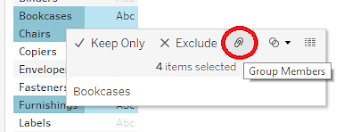Difference between sets and groups in tableau

As a tableau enthusiast, I always see similar questions on the tableau community and in today's blog, we will address that. If you are new to tableau then you must be perplexed about the use of groups and sets in tableau. It troubled me a lot in the beginning and after using tableau for a significant period I realized that it's not that difficult and you can identify the purpose after using it. Let's dwell around it and highlight the differences. Before highlighting the differences we will understand what is a group in tableau? As the name suggested you can group different members into a particular group without any condition associated with it and it will create a new dimension every time. The definition can be confusing at times so let's dig deep into it by taking a closer look at how a group works in the Tableau public. I am using sample superstore data. Before creating a group let's understand the idea behind it. I am taking the subcategory and we are looking t...




